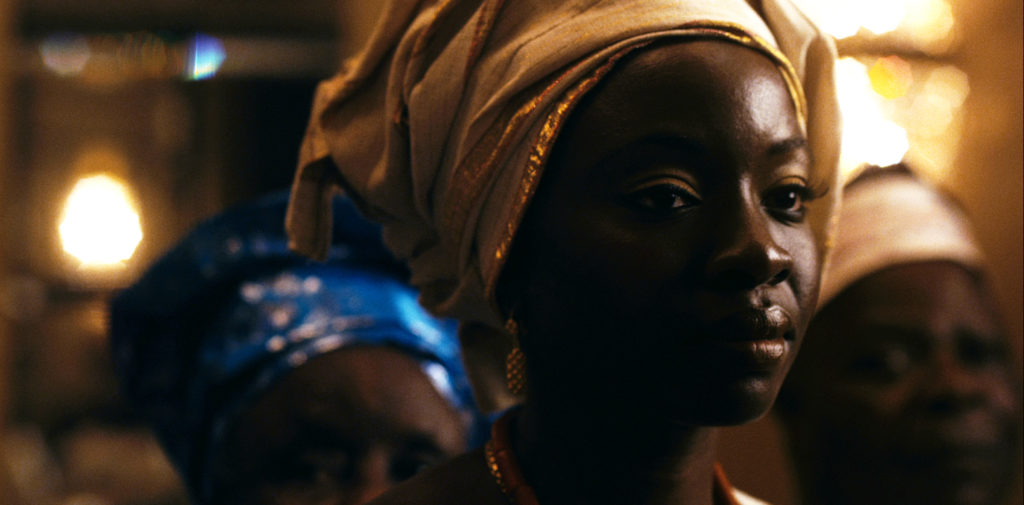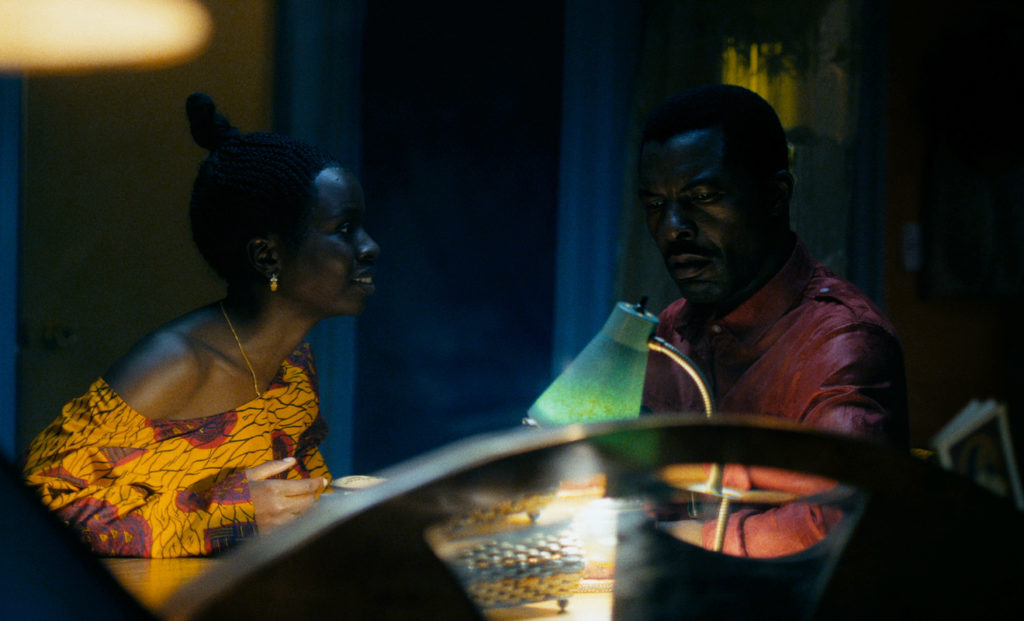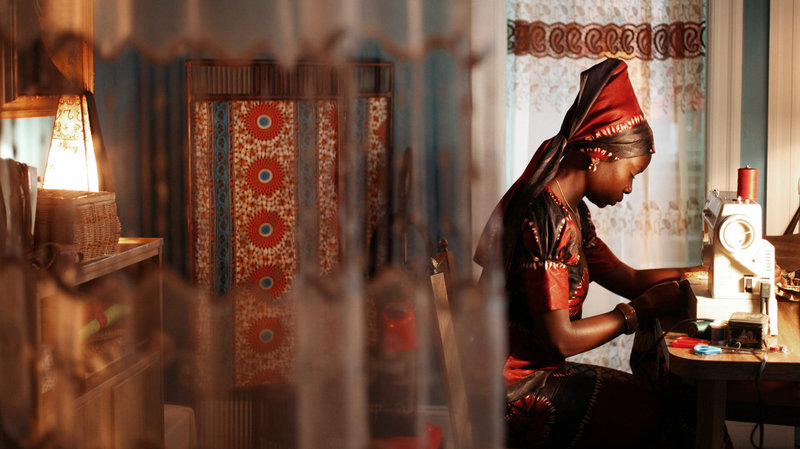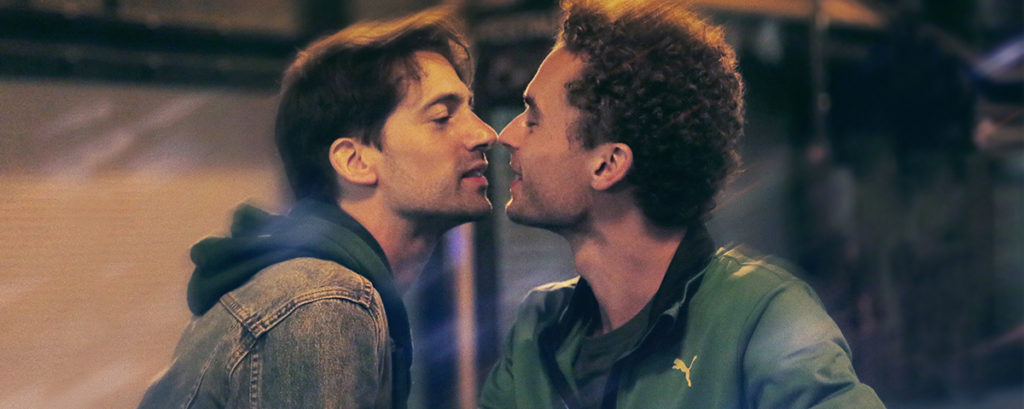
In Andrew Dosunmu’s Mother of George (2013), a family drama about a couple trying to conceive a child, Dosunmu and cinematographer Bradford Young play with light, colour and skin to produce a haunting, melancholy glare that speaks to the viewer both aesthetically and metaphorically. As Charles Mudede writers in The Stranger, the film “has no fear of the darkest spaces, the blackest bodies, and the lowest visibility; it transforms all three into a fugue of sheen, shine, and surfaces.” [i] This is equally true of colour, and it is the composite fusion of these styles that produces a tiered softness and sharpness to the film and its characters.
Mother of George opens on blurry shots of the bodies, signposts and sidewalks of New York City. In a sharp contrast, the next scene jumps to a lush wedding ceremony, where the lustrous colours and shimmering lights draw us in and keep us there. Men clad in their yellow caps surround a groom, Ayo (Isaach de Bankolé), and women in their elegant aso okes hover lovingly around the bride, Adenike (Danai Gurira), whose face is covered. In these two scenes, Dosunmu’s affinity for working with soft visuals and striking colours is abundantly clear. At the wedding of Adenike and Ayo, the fabrics are a highlight of the ceremony—at times, they seem even more important than the people. The visual layering of ochre wax prints, shiny foreheads and metal centrepieces seem to reflect all the light in this otherwise subdued moment.
Ayo walks in, prostrates before his family, and is blessed with good health, good children and a long life. He is told that the family will always be there for him. Then Adenike dances in, lit by the candles in the middle of the room. Her blessings are pronounced: “Adenike, you and your husband, nothing will ruin you two. You will give birth to a son…you will give birth to a daughter, too. You will give birth to twins as well. You and your husband will not know suffering. You will sit and enjoy your children.” Adenike never speaks, but at the end of the wedding scene, the camera zooms in on her face and she is finally shown, visible underneath all the light and new burdens of wifedom. There are several figurative shadows that dance around this celebration, but the spectacular clothes seem to overpower the bodies they cling to, perhaps with the promise that the ebullient celebration will continue into Adenike and Ayo’s marriage.
Like a background hum, their presence and importance hangs over every scene, either through the changes in focus in a given scene or in the play between light and shadows, bright colours and dark skin.
Through these first scenes, Dosunmu’s mechanisms with light and inanimate objects produce a soft sentimentality that lingers around the characters. Adenike’s marriage to Ayo takes place with their families and each other, but also amongst the tablecloths, curtains and plates that inhabit their new domestic world. Dosunmu is able to make these objects central figures by playing with the focus of the camera, and by blurring the human subjects that surround them. In this way, the drama of Adenike’s life is subsumed by the soft inanimate objects that Dosunmu’s camera lingers on — their stillness, and presence as witnesses, delivers unto them a discreet, persistent softness that pervades the entirety of the film. Like a background hum, their presence and importance hangs over every scene, either through the changes in focus in a given scene or in the play between light and shadows, bright colours and dark skin.
On her wedding night, two women give Adenike advice in the bedroom. Her shoulders are bare, and her skin looks blue, reflecting the glow from her mother-in-law’s dress. We are submerged into the secrecy of the night, as only dim light dances on their faces. Ma Ayo (Bukky Ajayi), Adenike’s mother-in-law gives the new bride beads to ensure fertility and prosperity; the camera’s focus moves away from the women’s faces and, off-screen, the beads click in Ma Ayo’s now-disembodied hands. This presents a disjointed relationship between the two women, reaffirming the primacy of objects like the beads as the vehicles of tenderness between the new family members. Adenike slips the beads around her waist and Ma Ayo tells her that if she prays every day, she will bear a son. Adenike kneels, crying, and the two women hug, as the camera captures the top of Adenike’s cornrows swallowed by the darkness. It is here that the mandate for her marriage is given: she must bear a male child, who will be named George in honour of her late father-in-law. In playing off the gentle blue light against the darkness, Dosunmu mediates an atmosphere of trust and precaution between Adenike and her mother-in-law. While the visible radiance between the two women makes this scene an intensely affectionate one, the foreshadowing of problems to come in the literal shadows of the scene is poignantly unmistakable.

Adenike quickly adapts to her role as a wife: she cooks and brings food to her husband at the restaurant he runs in the city. She is dutiful and hardworking, the movements of her hands quick and practiced in her daily chores. But Adenike’s interactions with her husband are often shot from behind a lamp, windowpane or door, and often these objects are blurred or lit up more sharply than everything else. This inflects a visual complexity to Adenike and Ayo’s scenes, but also creates distance between the viewer and them—as if the audience is seeing the couple through a veil. Visually, this separation heightens the sense of intrusion, and leaves room to adopt an inanimate viewpoint. As a kind of dormant witness, the spectatorial vision is rendered soft.
A few months into her marriage, when Adenike fails to get pregnant, her mother-in-law routinely begins to check up on her. In the privacy of their home kitchen, Adenike begins to share her frustrations with her husband. Here, Dosunmu shoots from behind intricate lace curtains, or from the corner of the table — all of these visual vantage points from which sights of the characters are fragmented. We only see their hands, their bodies from the neck down, or a twitch in their faces. By drawing his camera away from the characters to their furniture and disembodied gestures, Dosunmu’s vantage points often work to soften the intensity of conflict. We see the duality of the inanimate and human, and we witness tense and affectionate moments through the threads of delicate cloth.
Transparency and softness reappear as a point of contention for Adenike and Ayo early in their marriage, when Adenike’s American cousin Sade (Yaya Alafia) buys her a sheer blouse. Adenike appears at the restaurant wearing the blouse instead of her traditional print shirt, hoping to please Ayo. He tells her that although he likes the shirt, what’s under it is “not for everyone to see.” This play on transparency and exclusive viewing rights becomes a problem for their relationship, as Adenike is shown, head wrapped, wearing the light blue shirt, with her striped black and white bra visible underneath. The pair stands in Ayo’s restaurant, blurry behind glass that reflects their bodies, the clashing colours of their clothing, and the cars on the streets. The use of reflections here, as well as the struggle with what is appropriate for transparency, creates what Guy Lodge calls a “suitably prismatic context”[ii] for the realities that each of the characters are trapped in. It hints at the secrecy and deceit that will follow, questioning how clearly we, the audience, are able to understand the characters, but more so, how transparent Ayo and Adenike are to each other, and even to themselves.
By drawing his camera away from the characters to their furniture and disembodied gestures, Dosunmu’s vantage points often work to soften the intensity of conflict.
As the months go by, Adenike begins to not only feel the pressure of conceiving, but also struggles for her own independence by looking for a paying job. After 18 months with no pregnancy, Adenike tries to convince Ayo to see a fertility doctor with her, but he angrily refuses. Adenike is desperate and Ayo’s refusal to move forward with her ideas leaves her at a dead end. A few days later, Adenike’s frustrations boil over, as she yells into the phone “But why? Why is it always the woman!” When she sees her husband talking to other women at a party, Adenike seems to dissociate from her reality: the camera zooms in on her eyes and nose as everything else fades into the black night. Instead of being a person who brightens a room with her clothes and smile, Adenike is shrinking: she paces frantically in dim light, visiting a spiritual doctor who spits water against her back and tells her she will be fine, and wanders the streets as if in a daze. In those scenes, the film shifts to slow motion, capturing her dissociative state through shots of her ochre skirt gliding along the pavement. Adenike seems to be slipping away from everything, because she too blurs as she walks all through the city.
Adenike shares her desperation with Ma Ayo, and worries that Ayo might be impotent. Ma Ayo’s solution is for Adenike to sleep with Ayo’s brother Biyi (Tony Okungbowa), a prospect she defends because “it’s the same blood. Only a woman knows who the father is.” They talk in hushed tones in a church against a backdrop of song, heavy cloth robes and curtains, and gilded architectural accents. Unlike their earlier exchange of beads, this scene recalls the opulence of the wedding, indicating that the two have found a bright, clear solution to a murky problem. But in the scene where Adenike finally has sex with Biyi, her skin is so dark it glistens, her head is turned away, and the creaking bed is the only other witness. Here, the gaiety of Adenike’s yellow head-wrap is turned morbid, and the sheen that strikes her face illuminates her perplexed and worried face. A few months later, pregnant Adenike is only able to hide the secret from Ayo for so long. When she breaks down and confesses, once more their darkened faces are highlighted by the green walls and gold lighting of their bedroom, reflecting the intensity of Ayo’s hurt and Adenike’s guilt in the face of a desperate situation.

Dosunmu and Young’s visual language in Mother of George is both stunning and vital to the story of Adenike and Ayo. It is with the spirit of these aesthetic presentations that we are able to feel the depths of Adenike’s dizzying despair, as well as her highest highs—when she thinks she’s given her husband what he wants. By the end of the film, Adenike has adopted her mother-in-law’s refrain (“It is the same blood”), but her attempts to preserve the safe and soft promises of her wedding only unearth the sharpness that lies beneath. Ultimately, this softness marks Adenike (whose material reality is filled with so much toughness) as multidimensional, as human.





